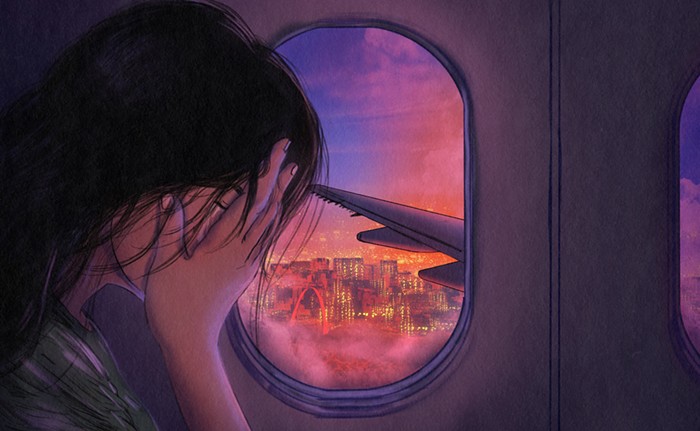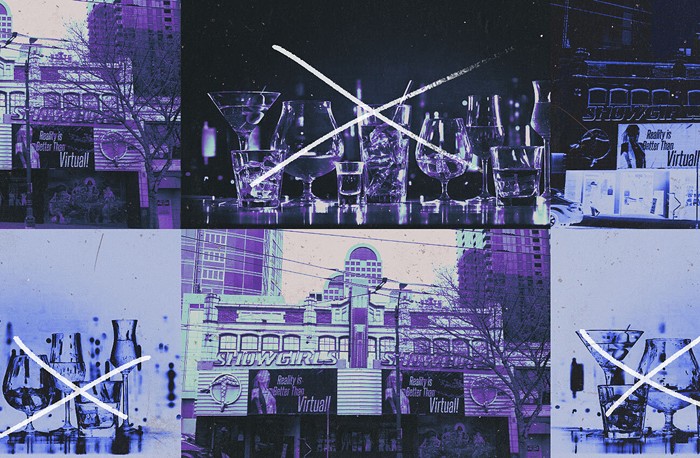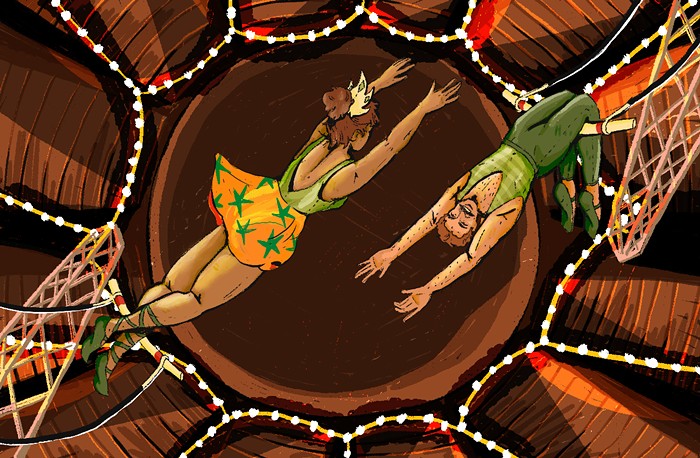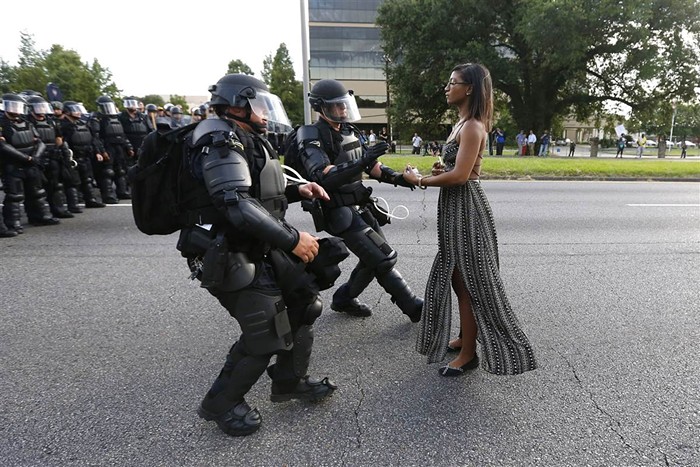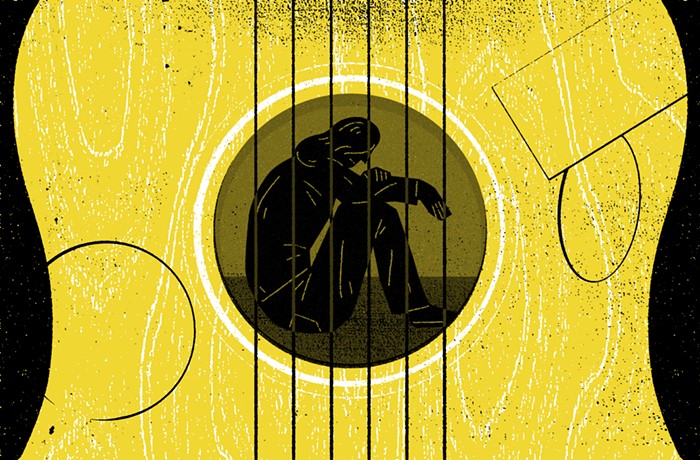QUESTIONS
Q: Is it true that Real World is coming to Seattle?
A: It appears so. Though Bunim/Murray Productions has yet to officially confirm, I have an e-mail from a member of the art department soliciting crew members. They were seeking a shopper and an art department PA, and the pay is $150 per day with a guaranteed five weeks of work—not bad by Seattle independent film standards. The start date for both jobs was May 16. So they're not coming. They're already here.
Q: Will the cast really be living on Capitol Hill?
A: They will, at 1517 12th Avenue, between Pike and Pike, right next door to Northwest Film Forum, upstairs from Juicebox, down the block from the police station, and one block from Stranger HQ.
Q: Real World is still on the air?
A: It is. This will be season 32 and the only major change to the formula—gaggle of moderately unalike youths share living space—came two years ago, in season 29 (San Francisco, for the second time), when producers dropped The from the show's title. Since its premiere in 1992, Real World has never not been on the air.
Q: How can this be happening?
A: Because we asked for it. I don't mean we literally asked for it, although that's not out of the question. The production will mean a handful of jobs for talented local film/video production crew members, and it bangs the drum for more out-of-town productions, so it's possible local arts bureaucrats begged Real World to come back.
But out here in the rest of the world, the grim reality (pardon the expression) is that Seattle in 2016, specifically Capitol Hill, and even more specifically the neighborhood where they'll be living, is the PERFECT place to shoot another season of Real World: Seattle. Walking around Pike/Pine on a weekend night is already like shouldering your way through a cattle call audition for a Bunim/Murray production: conventionally attractive normals who occupy the spectrum between bad taste and no taste and share a penchant for flaunting their drunkenness in shaky handheld videos.
This isn't a new observation. It's just how Seattle is now. Complaining about it, even noticing it, has become a cliché. The same can be said of the phenomenon of reality TV. Plenty of smart, well-meaning people have noted the way the format preys on our lowest impulses, makes us voyeurs, devalues artistry, cheapens the essential nature of love, friendship, and humanity, isn't even real. But it has stuck around long enough for its more grotesque elements—which have always been the core of its appeal—to seem completely normal, like talking on the phone in a movie theater or Prince and David Bowie being dead.
"FUCK THE REAL WORLD"
The last time Real World came to Seattle, the only excitement I remember happening locally was at the prospect of sabotaging the production any way possible. Back when cameras were rare and money was a rumor, The Stranger sponsored a Real World Paparazzi Contest with a $1,000 first prize and started a gossip column (TTS, which stood for This Town Sucks) with the express purpose of humiliating anyone involved with the show. But before you make that sound you make when you talk about this paper's relationship to negativity, we were merely giving voice to a feeling that was being expressed all over town. A lot of people made T-shirts that said things like "Fuck the Real World" or "The Real World Sucks" and vowed to make an obscene, culture-jammy spectacle if they even glimpsed a TV camera.
What cultural event has more thoroughly united the city since? The Seahawks winning the Super Bowl? Obama's election night? The WTO? Nobody wanted The Real World: Seattle—nobody who didn't work for Viacom or Entercom or Bunim/Murray or wanted one of the show's insanely scarce production jobs, that is. It was 1998. The first tech bubble was furtzing around the room like a punctured balloon. A small population of 26-year-old beta-bros who had briefly been on-paper millionaires had to go find honest work. The Seattle music boom was over and a less hysterical, more interesting music scene was gaining momentum. It even looked like we might get a citywide monorail (sheeeeeeeeeeeeeeit). In short: This was no time for a bunch of TV dipshits to start strip- mining Seattle's cool ore again.
Seattle. Did. Not. Want. The. Real. World.
But we got it. There were a few minor disruptions. Cast members were greeted with boos at public appearances, like radio DJs introducing bands at a rock show—which was only appropriate, since they were given jobs at The End.
"The citizens in Seattle hated us," cast member Irene McGee recalled in 2013. "One night, a guy jumped into the booth at a bar when we were taping, landed on my head, and said, 'Fuck The Real World.'"
McGee, you will definitely recall, was the one with Lyme disease, also the one who got slapped by her male castmate on camera.
I have a dim memory of an attempted protest at Sit & Spin, a (fantastic) rock club/laundromat in Belltown where the cast was planning to take in a show. Six or seven people donned their "Fuck the Real World" T-shirts and headed to the club, determined to ruin as many shots as possible. But the camera operators had become adept at shooting around such disturbances, and the righteous mischief played out like harassment to the tech crew members who were just trying to do their job, and an annoyance to the rest of the room, who were just trying to see a band. The would-be culture jammers wound up looking like hopeful actors desperately trying to get the indifferent TV eye to notice them.
The Stranger's Real World Paparazzi Contest didn't fare much better. Though video cameras weren't quite rare, they were a luxury item, and they were the size of a briefcase, and the technology to transfer and edit video footage was still the province of pros. Digital still cameras were also brand-new and scarce, which meant shooting on film, taking it to the shop, waiting to get it developed, and zzzzzzz. We received a few entries, but no one remembers them being any good.
INFINITELY MORE CYNICAL
The case against The Real World was cultural, but it was aesthetic, too.
The basic idea was that Seattle, the real Seattle, our Seattle, was not about to let some fake-ass television show (not that anyone admitted to watching television) come into our little paradise (which we complained about constantly) and shoplift the essence we'd worked so hard to cultivate (though "we" had only borrowed or inherited it, and most people would agree that the best of it had ended long before any of us had gotten here). Especially not for the benefit of M fucking TV.
MTV which had, only a few years earlier, elevated a small handful of Seattle musicians to international fame, turned the word "Seattle" into a brand and set off a chain of events that left a lot of people feeling burned, a lot of other people feeling burned out, and a handful of beloved and talented people dead. (I mean, you can't blame a cable TV channel, but people did.)
The Real World made a big splash, but the idea that MTV made original, non-music-related programming (Beavis and Butthead notwithstanding, obviously) was still widely scoffed at by the generation of people who had grown up identifying with the network. You could still complain then that MTV didn't show enough music videos anymore. The Real World, and its Wacky Races–style spin-off, Road Rules, were exercises in the conflation of music with a certain kind of lifestyle brand consumption, a certain kind of self. Which is exactly what MTV had always been. It's just that now they had figured out a way to eliminate musicians from the equation.
It's quaint to recall a time when this felt like a violation.
The show was garbage, but it was worse than that, too, because it came shrouded in youthful sincerity. It was posited as a diverse group of young people finding themselves and learning to work through their differences. Together. It sold self-discovery. It sold friendship. It sold diversity (it had been a big deal when one of the cast members was gay). It sold community. How much more cynical could you get? (Spoiler alert: Infinitely more cynical.)
Worst of all, in its early years, like most shows that have followed its lead, The Real World was really entertaining and addictive.
Way, way back when, back in the first few seasons, back before the repetition and micro-suspense building techniques of reality show editing had become fully codified, The Real World had the power to dupe us into being fascinated by people we would cross a room to avoid speaking to in real life. And we resented it. Reality TV wasn't really a thing yet. (Neither was "a thing.") People still objected to the artificial food processing of blatantly stage-managed footage to create dramatic tension and character conflict without the protective distance of fiction. The name of the show was an affront. It wasn't MTV. It wasn't real. It wasn't the world. Everything about it was a joke. And if there was one thing this city didn't have in 1998, it was a sense of humor—about itself, or anything else.
A lot has changed since then, but not that.
MEANWHILE, BACK IN 2016
There's a way to view the Real World Seattle 2.0 as a nonevent. MTV—which came clean and officially dropped the words "Music Television" from its name six years ago—is scorched earth, one of a zillion cable channels showing nearly identical reality programming on a loop. In the race for cultural relevancy, the show itself has been lapped by the many shows that share its DNA. The youth culture it was bred to feed doesn't use television the same way anymore. Real World isn't competing with Game of Thrones or Netflix; it's competing with cell phone videos from Sasquatch. There are Instagram posts with larger audiences.
David Meinert, owner of Lost Lake, Comet Tavern, and Big Mario's, among other local businesses, told KIRO radio that he won't allow the show to shoot in his establishments. "I think the show encourages these kids to act like idiots for the cameras and do drunken, stupid antics," he said. "I don't want any of that in my businesses."
I'm not the first—or the 100th—to point out that Real Worlders would have to jostle for space with the drunken idiot antics that are already swarming those businesses on weekends, but I still think the principle Meinert's asserting is admirable. The Real World 2016 is just another dude talking too loud while waiting for a slice of pizza that he vomits up on the sidewalk five minutes later while his friends laugh and stream the scene on Periscope. No need to give them keys to the city.
But it's unlikely that the cast and crew of this new Real World will meet any resistance. Why would they? Even the ineffectual kind that met the 1998 season would be absurd in 2016. Does anyone regard the presence of cameras as an affront anymore? Does anyone feel betrayed by MTV anymore? Are there bands out there that worry about being compromised by overexposure? Isn't the internet basically a giant paparazzi contest already?
ONE LAST QUESTION
Q: Why do all these old people keep talking about some show I've never even heard of? GOD.
A: Hang on there, junior. Writing about Real World in GQ, John Jeremiah Sullivan dismissed all the standard criticisms people like to level at it because they all miss "the single most interesting thing about reality TV, which is the way it has successfully appropriated reality." A generation of people whose consciousness was formed by watching these shows has moved collectively "toward a greater self-consciousness, greater self-reflexivity, more uniform complicity in the falseness of it all."
Look no further than Donald Trump for evidence of how powerful and malignant our complicity can be. Compared to that—compared to a reality TV star who is one election away from the White House despite having no charisma, no convictions, and no compunction about appealing to America's lowest prejudices to keep his numbers up—the Real World coming back to Seattle doesn't seem like the end of the world at all. ![]()

